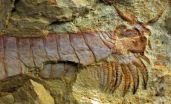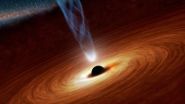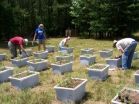(Press-News.org) Protection of marine areas from fishing increases density and biomass of fish and invertebrates (such as lobster and scallops) finds a systematic review published in BioMed Central's open access journal Environmental Evidence. The success of a protected area was also dependent on its size and on how it was managed, however even partial protection provides significant ecological benefits.
Marine ecosystems worldwide are suffering from a loss of biodiversity due to destruction of food chains and habitats. Increasingly areas are being set aside to protect sensitive environments and species, or to provide a safe pocket from which fish and larvae can re-seed over-exploited seas.
By performing a meta-analysis, the Centre for Evidence-Based Conservation and School of Ocean Sciences at Bangor University and the National Oceanography Centre Southampton found that protection of marine areas increased fish density and that even partial protection increased fish biomass by almost 50%, while fully protected 'no take' areas had double the biomass. This effect was most noticeable for target species, which were the reason the protection areas were set up. In particular lobsters and scallops showed a positive response to partial protection. None of the styles of protection increased the number of fish species.
Overall marine protection is a success story however the success of a reserve also depended on its size and how it was managed. Marija Sciberras, from Bangor University, explained, "Even within partial protection reserves there was variation - the ones which allowed recreational fishing had more biomass than open areas, whereas the ones that were previously commercially dredged showed no real improvement relative to open (or fished) areas. Interestingly we found that increasing the size of partial protection areas above 1000km2 reduced their effectiveness. While this is worrying, we suspect that it may be due to increased poaching."
###
Media contact
Dr Hilary Glover
Scientific Press Officer, BioMed Central
Tel: +44 (0) 20 3192 2370
Mob: +44 (0) 778 698 1967
Email: hilary.glover@biomedcentral.com
Notes
1. Evaluating the biological effectiveness of fully and partially protected marine areas
Marija Sciberras, Stuart R Jenkins, Michel J Kaiser, Stephen J Hawkins and Andrew S Pullin
Environmental Evidence (in press)
Please name the journal in any story you write. If you are writing for the web, please link to the article. All articles are available free of charge, according to BioMed Central's open access policy.
Article citation and URL available on request on the day of publication.
2. Environmental Evidence is the open access, peer-reviewed journal of the Collaboration for Environmental Evidence (www.environmentalevidence.org) that facilitates rapid publication of systematic reviews and evidence syntheses which report on the effectiveness of environmental management interventions and on the impact of human activities on the environment.
3. BioMed Central (http://www.biomedcentral.com/) is an STM (Science, Technology and Medicine) publisher which has pioneered the open access publishing model. All peer-reviewed research articles published by BioMed Central are made immediately and freely accessible online, and are licensed to allow redistribution and reuse. BioMed Central is part of Springer Science+Business Media, a leading global publisher in the STM sector. @BioMedCentral
4. Bangor University's School of Ocean Sciences, a multidisciplinary department, and one of the largest university Marine Science departments in Europe. The University has a long record of academic excellence and has particular strengths in the fields of Environmental Science (including Ocean Sciences), Health (including Psychology, Neuroscience and Sports Science), Humanities, Physical Sciences, Business, Law, Social Sciences and Education. It is a research-led university, and the 2008 Research Assessment Exercise demonstrated that it had 'world-leading' research in every subject area assessed.
How much protection is enough?
2013-02-28
ELSE PRESS RELEASES FROM THIS DATE:
First signs of heart disease seen in newborns of overweight/obese mums
2013-02-28
The walls of the body's major artery - the aorta - are already thickened in babies born to mums who are overweight or obese, finds a small study published online in the Fetal and Neonatal Edition of Archives of Disease of Childhood.
Importantly, this arterial thickening, which is a sign of heart disease, is independent of the child's weight at birth - a known risk factor for later heart disease and stroke.
And it may explain how overweight/obese mums could boost their children's subsequent risk of cardiovascular disease, suggest the authors, who point out that more ...
Every degree fall in winter air temperature equals 1 percent drop in ambulance response time
2013-02-28
[Ambulance call-outs and response times in Birmingham and the impact of extreme weather and climate change Online First doi 10.1136/emermed-2012-201817]
Every one degree fall in outside air temperature during the winter corresponds to a drop in ambulance response time of more than 1 per cent, reveals research published online in Emergency Medicine Journal.
Increased demand and treacherous road conditions during the winter months combine to stretch ambulance services in England, which have a target of reaching 75% of immediately life-threatening (category A) calls within ...
Discovery opens door to multipronged attack against skin common cancer, Stanford study shows
2013-02-28
STANFORD, Calif. — Hailed as a major step forward in the effort to develop targeted cancer therapies, a recently approved drug for the most common type of skin cancer has been a mixed blessing for patients. Although the initial response is usually dramatic, the tumors often recur as the cancer becomes resistant to treatment.
Now researchers at the Stanford University School of Medicine have identified a second way to block the activity of the signaling cascade, called the Hedgehog pathway, that is abnormally active in these cancers. The researchers hope the new approach ...
Feeding limbs and nervous system of one of Earth's earliest animals discovered
2013-02-28
An extraordinary find allowing scientists to see through the head of the 'fuxianhuiid' arthropod has revealed one of the earliest evolutionary examples of limbs used for feeding, along with the oldest nervous system to stretch beyond the head in fossil record.
Until now, all fossils found of this extremely early soft-bodied animal featured heads covered by a wide shell or 'carapace', obscuring underlying contents from detailed study.
But a new fossil-rich site in South China has been found to contain arthropod examples where the carapace has literally been 'flipped' over ...
What is the cost of rare diseases such as Friedreich's Ataxia?
2013-02-28
What is the cost of rare diseases such as Friedreich's Ataxia? By analyzing direct and indirect costs of care research in BioMed Central's open access journal Orphanet Journal of Rare Diseases calculated that conservatively this rare disease costs between £11,000 and £19,000 per person per year. Proper understanding resource allocation is important in minimizing the effect of Friedreich's Ataxia on people's lives while maximizing their quality of life.
Diseases are classified as 'rare' if they affect less than 1 in 2000 people. Lack of scientific knowledge means that ...
IV fluids used by NHS responsible for unnecessary deaths
2013-02-28
Starch-based intravenous (IV) fluids used by the NHS to treat seriously ill patients are causing unnecessary deaths, according to a new Cochrane systematic review by researchers at the London School of Hygiene & Tropical Medicine.
Based on data from 25 randomised control trials, the researchers concluded that starch-based colloid fluids, used to stabilise patients with low blood pressure, are not only more expensive than saline-based crystalloid fluids, but may also be causing around 250 unnecessary deaths in the UK every year.
The study included 9,147 seriously ill ...
Supermassive black hole spins super-fast
2013-02-28
Imagine a sphere more than 2 million miles across - eight times the distance from Earth to the Moon - spinning so fast that its surface is traveling at nearly the speed of light. Such an object exists: the supermassive black hole at the center of the spiral galaxy NGC 1365.
Astronomers measured its jaw-dropping spin rate using new data from the Nuclear Spectroscopic Telescope Array, or NuSTAR, and the European Space Agency's XMM-Newton X-ray satellites.
"This is the first time anyone has accurately measured the spin of a supermassive black hole," said lead author Guido ...
Silver nanoparticles may adversely affect environment
2013-02-28
DURHAM, N.C. -- In experiments mimicking a natural environment, Duke University researchers have demonstrated that the silver nanoparticles used in many consumer products can have an adverse effect on plants and microorganisms.
Fifty days after scientists applied a single low dose of silver nanoparticles, the experimental environments produced about a third less biomass in some plants and microbes.
These preliminary findings are important, the researchers said, because little is known about the environmental effects of silver nanoparticles, which are found in textiles, ...
Research explores factors that impact adolescent mental health
2013-02-28
Research indicates that half of all lifetime cases of mental illness begin by age 14, well before adulthood. Three new studies investigate the cognitive, genetic and environmental factors that may contribute to mental health disorders in adolescence. The studies are published in Psychological Science and Clinical Psychological Science, journals of the Association for Psychological Science.
Social-Information-Processing Patterns Mediate the Impact of Preventive Intervention on Adolescent Antisocial Behavior
Kenneth A. Dodge, Jennifer Godwin, and The Conduct Problems ...
NuSTAR helps solve riddle of black hole spin
2013-02-28
An international team including Lawrence Livermore National Laboratory scientists has definitively measured the spin rate of a supermassive black hole for the first time.
The findings, made by the two X-ray space observatories, NASA's Nuclear Spectroscopic Telescope Array (NuSTAR) and the European Space Agency's XMM-Newton, solve a long-standing debate about similar measurements in other black holes and will lead to a better understanding of how black holes and galaxies evolve.
"We can trace matter as it swirls into a black hole using X-rays emitted from regions very ...


